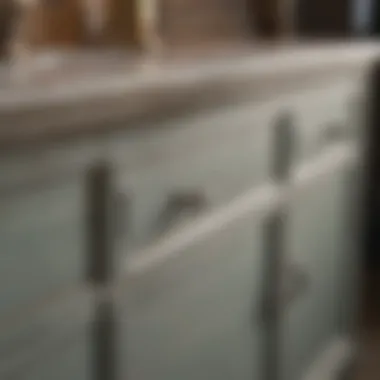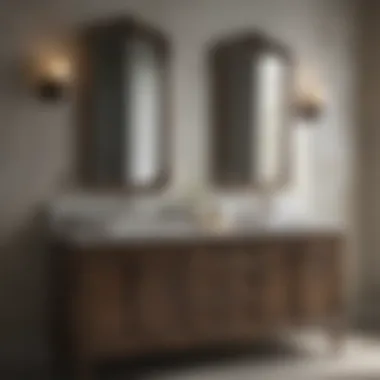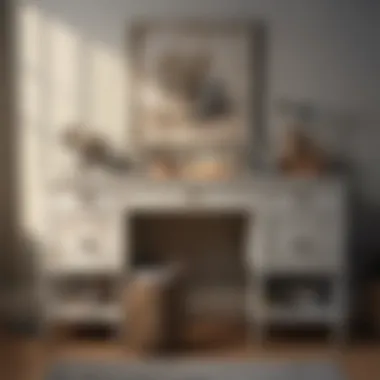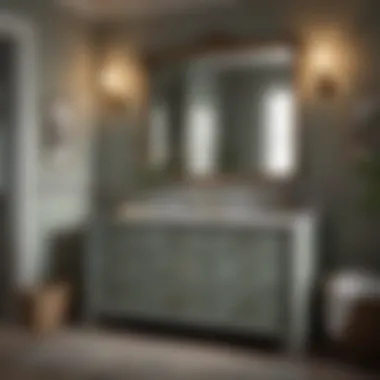Transform Your Bathroom Vanity with Chalk Paint


Intro
Transforming a bathroom vanity can breathe new life into your space. Using chalk paint is an increasingly popular method due to its unique properties and aesthetic appeal. This article provides a comprehensive guide on painting bathroom vanities with chalk paint. Homeowners and DIY enthusiasts alike will find value in the insights shared throughout this guide.
Chalk paint is favored for its matte finish and versatility. It adheres well to various surfaces without the need for extensive priming or sanding. This is particularly beneficial for bathroom furniture exposed to humidity and moisture. The ease of application makes it ideal for those looking to enhance their home decor without significant investment in time or resources.
In the subsequent sections, we will highlight the current trends in colors and styles for bathroom vanities, share visual ideas to inspire transformations, and walk through a detailed guide on preparation and application techniques. By the end, you will have the tools and knowledge needed to successfully complete your own vanity project.
Current Trends
Color Palettes
When it comes to color trends for bathroom vanities, certain shades stand out in 2023. Softer pastel colors are gaining popularity, appealing to those who prefer a more tranquil environment. Soft sage green, light blush, and dusty blue are commonly chosen for their ability to create calm spaces.
On the other hand, bold and dark colors are making a statement too. Shades like navy blue, charcoal grey, and even bold black add drama and depth to a bathroom. Homeowners often choose these colors to contrast against lighter walls or tiles, creating a striking focal point.
Popular Styles
The styles for painted vanities vary widely, with classic and modern designs coexisting. Shabby chic remains popular, characterized by distressed finishes and a soft, vintage look. This style appeals to those wishing to create a cozy atmosphere in their bathrooms.
Conversely, minimalist Scandinavian designs are favored for their clean lines and functional approach. These often utilize lighter colors and simple forms, promoting a serene and uncluttered space.
Visual Ideas
Inspiration can significantly impact your decision-making when embarking on a vanity project. Consider browsing through galleries that showcase stunning bathroom designs. These visual ideas help in imagining how your newly painted vanity could enhance your overall bathroom aesthetic.
Gallery of Styled Bathrooms and Bedrooms
The right combination of color and style can turn a bathroom into a personal sanctuary. Look for images that resonate with your vision. You might find unique pairings of chalk-painted vanities with complementary decor elements.
Before-and-After Transformations
Witnessing changes through before-and-after images can motivate you. These renovated spaces enable you to visualize the potential of your bathroom vanity. Often, a simple coat of chalk paint results in dramaticmakeovers. Observing these transformations helps clarify what you aim to achieve.
"A well-chosen color and a little paint can have a profound effect on the feel of any space."
By exploring the current trends and visual ideas, you can start to formulate a plan for your own bathroom vanity. Next, we will dive into the necessary tools, preparation steps, and application techniques needed to achieve that professional finish.
Intro to Chalk Paint
Chalk paint has become a popular choice among homeowners and DIY enthusiasts for its transformative capabilities, particularly in home decor. This introduction provides insights into its significance in the context of painting bathroom vanities. Using chalk paint can elevate the aesthetic of a bathroom, breathe new life into outdated or worn vanities, and offer a simple yet effective solution for home improvement projects.
The importance of understanding chalk paint lies in its unique attributes and application methods. It’s crafted specifically to deliver a matte finish and adhere well to various surfaces. Moreover, its minimal preparation requirements make it particularly attractive for those looking to undertake home enhancement projects without extensive knowledge of paint techniques.
Additionally, chalk paint is lauded for its versatility. Available in a wide array of colors and finishes, it allows homeowners to exercise creativity while ensuring durability and ease of use. Notably, this section will delve deeper into these elements, leading into a thorough exploration of how to effectively paint bathroom vanities with chalk paint.
"Chalk paint’s adaptability makes it suitable for both intricate and quick projects, redefining spaces without the need for professional help."
Understanding Chalk Paint
Chalk paint is characterized by its flat appearance and soft finish. It is made with an exterior chalk compound, which contributes to its texture and adherence qualities. Unlike traditional paint options, chalk paint requires less surface preparation, enabling users to achieve a beautiful finish more efficiently.
Additionally, this paint is water-based, meaning it is easy to clean up after use and does not have strong fumes. An essential point to note is that chalk paint can be used on various surfaces, including wood, metal, and even plastic, provided they are prepped correctly.
Origin and Development of Chalk Paint


The development of chalk paint can be traced back to the need for a versatile and user-friendly painting solution. Its origins are often associated with Annie Sloan, who introduced it to the market in the 1990s. Sloan’s innovative formulation was meant to simplify the painting process for individuals without extensive experience, allowing them to achieve high-quality finishes on furniture and home decor.
Over the years, the popularity of chalk paint has surged, partly due to the rise of DIY culture and the desire for personalized home aesthetics. With numerous brands now offering chalk paint products, users can choose from an extensive palette and find options that suit various budgets and preferences.
Properties and Characteristics
Chalk paint is distinguished by several key properties. Its adhesion enables it to bond well with surfaces without significant priming or sanding, which is a considerable advantage for busy homeowners. The texture of chalk paint gives surfaces a soft, matte appearance, providing a contemporary and sophisticated finish that can be easily distressed for a vintage look.
Another characteristic worth noting is the ease of application. The paint's thick consistency allows for different techniques, such as brushing, rolling, or even spraying, adapting to the unique needs of various projects. Furthermore, chalk paint can be layered to create depth and complexity, offering flexibility in design.
In summary, chalk paint stands out for its user-friendly nature and aesthetic appeal, making it a relevant choice for painting bathroom vanities. Understanding its properties and development can guide homeowners in making informed decisions regarding their remodeling projects.
Why Choose Chalk Paint for Bathroom Vanities
Choosing the right paint for bathroom vanities is crucial, as this decision can drastically influence both the aesthetic and functional lifespan of the furniture. Chalk paint has emerged as a favorite for many DIY enthusiasts and homeowners due to its unique qualities. This section delves into why chalk paint is a superior choice for bathroom vanities, emphasizing its durability, aesthetic versatility, and ease of application.
Durability and Resistance
One of the most notable advantages of using chalk paint on bathroom vanities is its durability. Chalk paint is known for its strong adherence to surfaces without the need for a primer. Once sealed properly, it withstands moisture commonly found in bathrooms, making it resistant to peeling and chipping. It creates a resilient finish that can endure the daily wear and tear associated with such high-use areas.
In addition, the blend of mineral and organic materials often found in chalk paint enhances its longevity. This means that even after years of use, your vanity can maintain its charm and character, reducing the need for frequent repainting. Homeowners can appreciate the long-term value chalk paint provides, allowing them to invest time upfront for significant rewards.
Aesthetic Versatility
Chalk paint offers an extensive color palette and finish options that can fit into any bathroom decor, from classic to modern. The matte finish often associated with chalk paint can give a soft, inviting look that enhances the overall ambiance of the space. Homeowners have the flexibility to choose from distressed finishes for a rustic feel or smoother applications for a more contemporary appearance.
The ability to layer different colors or finish allows for distinctly creative expressions. With chalk paint, experimenting becomes easy. Mixing colors or using multiple techniques (like waxing or glazing) enhances not only the vanity but the entire bathroom aesthetic. Thus, it becomes a piece of art in addition to its functional role.
Ease of Application
For those reluctant to embark on complex DIY projects, chalk paint is a great choice due to its straightforward application method. It typically requires minimal surface preparation, unlike traditional paints that necessitate sanding and priming. This time-saving aspect makes it attractive for busy homeowners seeking quick transformations.
Furthermore, chalk paint dries rapidly, allowing for quicker project completion. Subsequent coats can be applied within a few hours of each other, making it possible to finish a project in just one weekend. Tools required for application are also limited, often just needing a brush or roller, minimizing the hassle involved.
"Chalk paint can transform any bathroom vanity with minimal effort, making it an ideal choice for quick and effective home improvements."
Preparation Before Painting
Preparation before painting a bathroom vanity is essential for achieving optimal results. Effective preparation ensures that the surface of the vanity is clean, smooth, and ready to absorb the chalk paint properly. This part of the process cannot be overlooked, as it directly affects the durability and aesthetic appeal of the finished product. A well-prepared vanity can greatly reduce the risk of chipping and ensure that the paint adheres correctly.
Selecting the Right Vanities
When selecting a bathroom vanity for painting, it is crucial to assess its material and condition. Wood or engineered wood options are typically best, as they offer good adhesion for chalk paint. Avoid vanities made from laminate or plastic finishes, as they can be challenging to paint. Check for damages or rough spots, addressing these issues before you begin. A well-chosen vanity ensures that the painting process is smooth and delivers a satisfying outcome.
Necessary Materials and Tools
To successfully transform a bathroom vanity with chalk paint, specific materials and tools are required. Ensuring you have the right items can save time and enhance the final finish.
Chalk paint
Chalk paint is known for its matte finish and ease of use. Its unique formulation allows it to adhere well to various surfaces without the need for extensive priming or sanding. This paint is popular among DIY enthusiasts because it dries quickly and provides excellent coverage. One key characteristic is its ability to create a vintage or distressed look, which enhances the aesthetics of furniture. However, while chalk paint is great for application, it often requires a protective topcoat to enhance durability, especially in moisture-rich environments like bathrooms.
Brushes and rollers
Using quality brushes and rollers is essential for applying chalk paint evenly. Brushes are particularly effective for smaller areas and detailed work, ensuring that paint reaches every corner and crevice. Rollers, on the other hand, are ideal for larger flat surfaces, helping to speed up the process. Selecting the right sizes and materials for both tools can prevent brush strokes or roller marks, achieving a more professional look. It is best to use synthetic brushes with chalk paint to ensure an even application.
Sandpaper


Sanding the surface prior to painting is critical. This process removes imperfections and provides a suitable texture for the paint to grip. Fine-grit sandpaper is often recommended for smoothing surfaces without gouging the wood. By sanding carefully, one can achieve a
Step-by-Step Painting Process
Understanding the step-by-step painting process is vital for anyone looking to elevate their bathroom vanity. This phase includes methods that foster a smooth application and achieve a uniform finish. Taking time with each step pays off in the long run, as it ensures durability and visual appeal. If not correctly followed, the results can be disappointing. Thus, it is essential to engage with the nuances of the process.
Applying the First Coat
The first coat sets the foundation for the rest of the job. Before you begin, ensure that your workspace is well-ventilated. Start by dipping your brush or roller into the chalk paint. Remove any excess paint to avoid drips. Apply the paint in even strokes, following the grain of the wood if applicable. This technique will help to minimize brush marks. Make sure you cover all surfaces thoroughly, including corners and edges. A common mistake at this stage is not applying enough paint, which may lead to poor coverage.
Assessing the Coverage
After the first coat has dried completely, assess the coverage. It is essential to check for any spots that may be patchy or less covered. Look closely, as the dimensionality of light can affect how the paint appears. If necessary, touch up any areas that need more paint. Often, people overlook this vital evaluation step. A keen eye saves a lot of work later on and ensures a more polished outcome.
Applying Additional Coats
In most cases, one coat is not sufficient for a rich and opaque finish. Apply additional coats as necessary, generally two or even three. Allow each layer to dry thoroughly before proceeding with the next. Using a clean brush for each coat optimizes the overall finish. Be mindful of applying the additional coats evenly, as this is crucial for visual consistency across the surface. Skipping coats will lead to an uneven texture and appearance, compromising your efforts thus far.
Achieving Desired Finish
Finally, after applying the required number of coats, focus on achieving your desired finish. This stage involves any additional techniques to enhance the visual appeal. You may opt for techniques such as sanding lightly between coats for a smoother texture or distressing for a rustic look. The finish ultimately reflects your style preference. Remember, patience is key here, as rushing can detract from the overall effect, and the time spent will pay off when you see the final result!
Finishing Touches
Finishing touches play a critical role in the overall outcome of your bathroom vanity painting project. After all the hard work put into preparing and painting, these final steps can significantly enhance the look and durability of the paint job. It is essential to approach this stage with attention to detail.
Applying Topcoat or Sealer
Once the paint has dried completely, applying a topcoat or sealer is crucial to protect the newly painted surface. A good topcoat helps prevent scratches, chips, and moisture damage, which are common in bathroom environments. There are several options available, including matte, satin, and glossy finishes. Choose a finish that aligns with your design preferences and the overall aesthetic of your bathroom.
When applying the topcoat, it is advisable to use a clean brush or roller to avoid imperfections. Ensure that the paint underneath is fully cured before application. Follow the manufacturer's instructions regarding drying time and application techniques for best results. Pay particular attention to corners and edges, as these areas often demand extra care to ensure even coverage. Sealing your vanity not only enhances its durability but also simplifies cleaning, providing a long-lasting finish.
Curing Time Considerations
The curing time is the period during which the paint fully hardens and adheres to the surface. It is typically longer than the drying time and can vary based on the type of paint and environmental conditions. For chalk paint, it is vital to allow plenty of time for curing to achieve optimal hardness.
In most cases, the curing process can take anywhere from a few days to a couple of weeks. Avoid placing heavy items on the vanity or exposing it to water during this period. It is beneficial to familiarize yourself with the product specifications; different brands may have varying recommendations. Observing the necessary curing time helps ensure a robust and resilient finish that withstands the demands of a bathroom setting.
Final Touch-Ups
After the topcoat has dried, inspect the vanity for any imperfections. Minor issues may arise, such as streaks or uneven areas. A gentle sanding with fine-grit sandpaper can help smooth these spots. After sanding, a light touch with the paint or sealer can bring back consistency.
Additionally, check the hardware and fittings. Ensure that drawer pulls and knobs are securely attached and in good condition. It might even be the perfect time to upgrade these fixtures, as they can dramatically change the overall appearance of your vanity.
If you followed the steps carefully, your vanity should look fresh and inviting. Regular maintenance will also help keep it in optimal condition.
"Finishing touches are often what transform a project from ordinary to stunning. Don't overlook them."
By dedicating time to these final steps, you will extend the life of your vanity and increase satisfaction with your DIY project.
Maintaining the Painted Vanity
Maintaining the painted vanity is crucial for ensuring its longevity and aesthetic appeal. After you've achieved a fresh, beautiful finish with chalk paint, regular care is necessary to prevent wear and tear. Neglecting maintenance can lead to damage, and the originally stunning look might diminish over time. Maintenance not only preserves appearance but also enhances durability, allowing your investment to last longer.
Cleaning Recommendations


Routine cleaning of the painted surface is essential for maintaining its condition. Here are some recommendations to keep your vanity looking its best:
- Use a Gentle Cleaner: Opt for a mild soap solution or a cleaner specifically designed for chalk paint. Avoid harsh chemicals or abrasive cleaners that can strip the finish.
- Soft Cloths Only: Always use soft cloths for wiping down the surface. Microfiber cloths are a good choice as they are effective without scratching.
- Regular Dusting: Dust buildup can dull the surface. Make it a habit to dust the vanity regularly to keep it clean.
"A little routine care goes a long way in preserving the appearance of your painted surfaces."
Following these recommendations can help maintain the finish without causing damage. Furthermore, it's best to avoid excessive water exposure, as it can weaken the paint over time.
Repairing Scratches or Chips
Even with careful maintenance, wear and tear can occur. Here are steps to repair scratches or chips:
- Assess the Damage: Examine the area to understand the extent of the scratch or chip.
- Clean the Area: Gently clean the affected area with a damp cloth to remove dirt and debris.
- Apply Touch-Up Paint: Use chalk paint in the same color to fill in the chip or scratch. Apply it carefully, using a small brush for precision.
- Blend the Finish: Once dry, lightly sand the area if necessary, then add a topcoat if you want to match the sheen of the surrounding paint.
If done attentively, these repairs can help sustain the appearance of your vanity, making it look as good as new. Regular maintenance and timely repairs are key to enjoying your chalk-painted vanity for many years.
Common Mistakes to Avoid
When embarking on the journey of painting a bathroom vanity with chalk paint, understanding common mistakes proves valuable. These blunders not only affect the end result but can also lead to unnecessary frustration. Avoiding these pitfalls can save time and ensure a polished finish, making your effort worthwhile.
Improper Surface Preparation
Surface preparation is perhaps the most crucial step in the painting process. Many novices underestimate its significance. If the surface is not cleaned and prepped adequately, the chalk paint may not adhere correctly. This can result in peeling or chipping over time.
To prepare a surface effectively, start by removing any oils, dust, or residue. Use a degreaser or simply warm soapy water to clean the vanity. After washing, it is vital to let it dry completely. Sanding down the surface can also promote adhesion, especially if the original finish is glossy.
If you skip sanding, chalk paint may only sit on top instead of bonding with the surface. This can cause your beautiful paint job to falter. So, always take the time to prepare the vanity correctly; it is a key factor in achieving a lasting result.
Using Incompatible Sealers
After painting, the choice of sealer can significantly impact the finish. Some individuals may choose sealants or topcoats that do not work well with chalk paint. Using incompatible products can cause the paint to react poorly, leading to discoloration or an undesirable sheen.
It is essential to choose a sealer that is specifically designed for use with chalk paint. A water-based topcoat is often recommended, as it maintains the matte finish that chalk paint is known for. Applying the wrong type of sealer can lead to sticky surfaces or an uneven finish.
"Choosing the right sealer transforms the painted surface into a durable element of your bathroom, while ensuring your artistic choice shines through."
Additionally, follow the manufacturer’s recommendations when applying sealers. Some may require specific application techniques or drying times. Ensure to read all instructions to avoid disappointing outcomes in your paint project.
By being aware of these common mistakes, you can ensure a more successful and pleasing outcome when painting your bathroom vanity with chalk paint. Taking the time to properly prepare your surface and selecting compatible sealers are steps that lead to long-lasting beauty in your updated space.
Epilogue
In this article, we have unpacked the intricacies involved in painting a bathroom vanity with chalk paint. The conclusion serves a significant purpose. It consolidates the knowledge gained from each section, ensuring that readers leave with a clear understanding of the process and its many benefits.
The experience of transforming a bathroom vanity with chalk paint extends beyond the mere act of painting. It introduces a world of aesthetic possibilities while also being practical. Readers should remember that successful completion requires preparation, the right tools, and thorough application techniques. Organizing these elements allows for a smoother workflow, reducing stress during the project.
This process not only enhances the visual appeal of the vanity but also contributes to its durability; chalk paint is known for its long-lasting finish when applied correctly.
Recap of the Process
Throughout the process, we discussed several critical stages:
- Preparation: Selecting the right vanity and gathering necessary materials like chalk paint, brushes, and sealers. Proper surface cleaning and repairs are crucial steps that cannot be overlooked.
- Application: The painting process consists of applying coats, assessing coverage, and achieving the desired finish. Each coat plays a role in ensuring the final look is even and professional.
- Finishing Touches: Applying a topcoat or sealer provides added protection and enhances the glossy appearance of the finish.
- Maintenance: Post-painting, regular cleaning and repairing any scratches are essential to preserve both beauty and functionality.
By breaking down these stages, homeowners and DIY enthusiasts can tackle their projects with confidence.
Final Thoughts on Chalk Painting Bathroom Vanities
Chalk paint is an innovative solution for breathing new life into worn or outdated bathroom vanities. Its versatility, along with its ease of use, makes it a popular choice among homeowners. One of the striking benefits highlighted is the variety of colors and finishes available, which allows for personal expression. It’s essential, however, to consider the specific environment of a bathroom, where humidity and water exposure are factors that can influence the choice of paint and sealing methods.
Moreover, using high-quality products ensures longevity. An informed decision about these factors can lead to a well-finished vanity that not only looks good but withstands daily wear. Ultimately, chalk painting a bathroom vanity can be a rewarding experience, resulting in both aesthetic contribution and increased property value.
"A bathroom vanity painted with chalk paint not only becomes a focal point but also reflects the character of the home owner."



